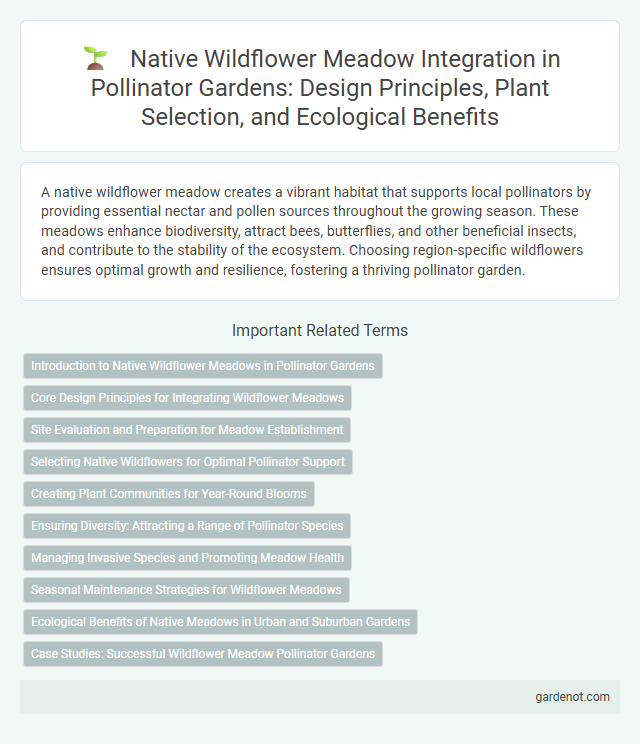A native wildflower meadow creates a vibrant habitat that supports local pollinators by providing essential nectar and pollen sources throughout the growing season. These meadows enhance biodiversity, attract bees, butterflies, and other beneficial insects, and contribute to the stability of the ecosystem. Choosing region-specific wildflowers ensures optimal growth and resilience, fostering a thriving pollinator garden.
Introduction to Native Wildflower Meadows in Pollinator Gardens
Native wildflower meadows in pollinator gardens provide essential habitats that support diverse bee, butterfly, and bird populations. These meadows feature region-specific plant species that bloom throughout the growing season, ensuring continuous nectar and pollen sources. Incorporating native wildflowers enhances ecosystem resilience while promoting pollination services crucial for local biodiversity and agriculture.
Core Design Principles for Integrating Wildflower Meadows
Native wildflower meadows support biodiversity by providing essential habitats for pollinators such as bees, butterflies, and hummingbirds. Core design principles include selecting regionally appropriate native species, ensuring a diverse plant structure to offer continuous bloom periods, and incorporating varied heights and densities to create microhabitats. Proper site preparation and maintenance strategies are vital for sustaining meadow health and maximizing pollinator attraction throughout the growing season.
Site Evaluation and Preparation for Meadow Establishment
Site evaluation for native wildflower meadow establishment involves assessing soil type, drainage, and sunlight exposure to ensure optimal growing conditions for pollinator-friendly plants. Soil preparation includes removing existing vegetation, adjusting pH with organic amendments, and loosening soil to promote root penetration. Proper site assessment and preparation increase the success rate of establishing a thriving pollinator garden that supports native bees, butterflies, and other beneficial insects.
Selecting Native Wildflowers for Optimal Pollinator Support
Selecting native wildflowers such as Echinacea purpurea, Asclepias tuberosa, and Rudbeckia hirta enhances pollinator diversity by providing essential nectar and pollen throughout the growing season. Prioritize species adapted to local soil and climate conditions to ensure robust growth and sustained habitat for bees, butterflies, and hummingbirds. Incorporating a variety of bloom times maximizes continuous foraging opportunities critical for pollinator health and ecosystem balance.
Creating Plant Communities for Year-Round Blooms
A native wildflower meadow supports a diverse plant community that ensures continuous blooms from early spring through late fall, providing vital nectar and pollen for pollinators year-round. Selecting a variety of species with staggered flowering times creates a resilient ecosystem that promotes soil health and attracts native bees, butterflies, and hummingbirds. Integrating grasses and perennials further enhances habitat stability and supports pollinator populations across different seasons.
Ensuring Diversity: Attracting a Range of Pollinator Species
Native wildflower meadows support a diverse array of pollinator species by providing varied floral resources throughout the growing season. Incorporating multiple native plant species with different bloom times ensures continuous nectar and pollen availability for bees, butterflies, hummingbirds, and other pollinators. This biodiversity fosters a resilient ecosystem, enhancing pollination efficiency and promoting long-term garden health.
Managing Invasive Species and Promoting Meadow Health
Managing invasive species in a native wildflower meadow involves regular monitoring and targeted removal of aggressive plants like Japanese knotweed and purple loosestrife to preserve biodiversity. Promoting meadow health requires practices such as seasonal mowing, prescribed burns, and soil aeration to encourage growth of native wildflowers like coneflowers, black-eyed Susans, and milkweed. Implementing integrated pest management and maintaining habitat diversity supports pollinator populations including bees, butterflies, and hummingbirds essential for ecosystem balance.
Seasonal Maintenance Strategies for Wildflower Meadows
Seasonal maintenance strategies for native wildflower meadows involve timely mowing to promote diverse plant growth and prevent invasive species. In early spring, removing accumulated debris enhances soil warming and seed germination, while late fall cutbacks help control woody plants and recycle nutrients. Proper seasonal care fosters a thriving pollinator garden by supporting native bees, butterflies, and other beneficial insects.
Ecological Benefits of Native Meadows in Urban and Suburban Gardens
Native wildflower meadows in urban and suburban gardens support biodiversity by providing essential habitats for pollinators such as bees, butterflies, and hummingbirds. These meadows improve soil health through natural nitrogen fixation and reduce stormwater runoff by enhancing soil infiltration. Incorporating native flora helps restore ecological balance, promotes local wildlife populations, and reduces maintenance needs compared to traditional lawn landscapes.
Case Studies: Successful Wildflower Meadow Pollinator Gardens
Case studies of native wildflower meadow pollinator gardens demonstrate significant increases in local pollinator populations, with species such as bumblebees, honeybees, and native butterflies thriving in these habitats. Studies from regions like the Midwest and Pacific Northwest reveal that diverse seed mixes including species like Echinacea purpurea, Asclepias tuberosa, and Solidago canadensis are essential for maximizing pollinator visitation. These successful gardens not only enhance biodiversity but also contribute to ecosystem services like improved crop pollination and soil health.
Native wildflower meadow Infographic

 gardenot.com
gardenot.com